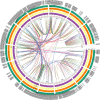Identification, evolution, and expression of GDSL-type Esterase/Lipase (GELP) gene family in three cotton species: a bioinformatic analysis
- PMID: 38129780
- PMCID: PMC10734139
- DOI: 10.1186/s12864-023-09717-3
Identification, evolution, and expression of GDSL-type Esterase/Lipase (GELP) gene family in three cotton species: a bioinformatic analysis
Abstract
Background: GDSL esterase/lipases (GELPs) play important roles in plant growth, development, and response to biotic and abiotic stresses. Presently, an extensive and in-depth analysis of GELP family genes in cotton is still not clear enough, which greatly limits the further understanding of cotton GELP function and regulatory mechanism.
Results: A total of 389 GELP family genes were identified in three cotton species of Gossypium hirsutum (193), G. arboreum (97), and G. raimondii (99). These GELPs could be classified into three groups and eight subgroups, with the GELPs in same group to have similar gene structures and conserved motifs. Evolutionary event analysis showed that the GELP family genes tend to be diversified at the spatial dimension and certain conservative at the time dimension, with a trend of potential continuous expansion in the future. The orthologous or paralogous GELPs among different genomes/subgenomes indicated the inheritance from genome-wide duplication during polyploidization, and the paralogous GELPs were derived from chromosomal segment duplication or tandem replication. GELP genes in the A/D subgenome underwent at least three large-scale replication events in the evolutionary process during the period of 0.6-3.2 MYA, with two large-scale evolutionary events between 0.6-1.8 MYA that were associated with tetraploidization, and the large-scale duplication between 2.6-9.1 MYA that occurred during diploidization. The cotton GELPs indicated diverse expression patterns in tissue development, ovule and fiber growth, and in response to biotic and abiotic stresses, combining the existing cis-elements in the promoter regions, suggesting the GELPs involvements of functions to be diversification and of the mechanisms to be a hormone-mediated manner.
Conclusions: Our results provide a systematic and comprehensive understanding the function and regulatory mechanism of cotton GELP family, and offer an effective reference for in-depth genetic improvement utilization of cotton GELPs.
Keywords: Biotic and abiotic stress; Cotton GDSL esterase/lipase; Evolution; Fiber growth; Tissue development; Transcriptomic expression; Whole genome duplication.
© 2023. The Author(s).
Conflict of interest statement
The authors declare no competing interests.
Figures










Similar articles
-
The binding pocket properties were fundamental to functional diversification of the GDSL-type esterases/lipases gene family in cotton.Front Plant Sci. 2023 Jan 18;13:1099673. doi: 10.3389/fpls.2022.1099673. eCollection 2022. Front Plant Sci. 2023. PMID: 36743561 Free PMC article.
-
Genome-wide identification of the GDSL-type esterase/lipase protein (GELP) gene family in Ricinus communis and its transcriptional regulation during germination and seedling establishment under different abiotic stresses.Plant Physiol Biochem. 2024 Sep;214:108939. doi: 10.1016/j.plaphy.2024.108939. Epub 2024 Jul 15. Plant Physiol Biochem. 2024. PMID: 39029309
-
Expansion and evolutionary patterns of GDSL-type esterases/lipases in Rosaceae genomes.Funct Integr Genomics. 2018 Nov;18(6):673-684. doi: 10.1007/s10142-018-0620-1. Epub 2018 Jun 13. Funct Integr Genomics. 2018. PMID: 29948460
-
Genome-Wide Identification of GDSL-Type Esterase/Lipase Gene Family in Dasypyrum villosum L. Reveals That DvGELP53 Is Related to BSMV Infection.Int J Mol Sci. 2021 Nov 15;22(22):12317. doi: 10.3390/ijms222212317. Int J Mol Sci. 2021. PMID: 34830200 Free PMC article.
-
Genome-Wide Classification and Phylogenetic Analyses of the GDSL-Type Esterase/Lipase (GELP) Family in Flowering Plants.Int J Mol Sci. 2022 Oct 11;23(20):12114. doi: 10.3390/ijms232012114. Int J Mol Sci. 2022. PMID: 36292971 Free PMC article. Review.
Cited by
-
Clinical insights into dental care for siblings with Jamuar syndrome: a rare genetic dual case report.Eur Arch Paediatr Dent. 2025 Aug 19. doi: 10.1007/s40368-025-01097-4. Online ahead of print. Eur Arch Paediatr Dent. 2025. PMID: 40828338
-
A GDSL esterase/lipase gene GbGELP identified from a fiber micronaire QTL qMIC-A11 modulates cell elongation and fiber development.Theor Appl Genet. 2025 May 25;138(6):126. doi: 10.1007/s00122-025-04915-x. Theor Appl Genet. 2025. PMID: 40413700
-
Haplotype shifts in the lipid-related OsGELP gene family underpin rice adaptation to high latitudes.Sci Rep. 2025 Sep 2;15(1):32293. doi: 10.1038/s41598-025-15488-6. Sci Rep. 2025. PMID: 40897734 Free PMC article.
-
Transcriptomic Characterization of Candidate Genes for Fusarium Resistance in Maize (Zea mays L.).Pathogens. 2025 Aug 6;14(8):779. doi: 10.3390/pathogens14080779. Pathogens. 2025. PMID: 40872289 Free PMC article.
References
MeSH terms
Substances
Grants and funding
LinkOut - more resources
Full Text Sources

